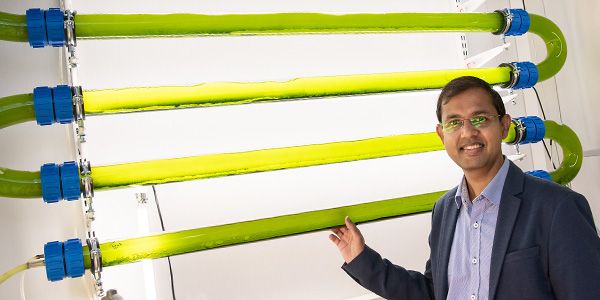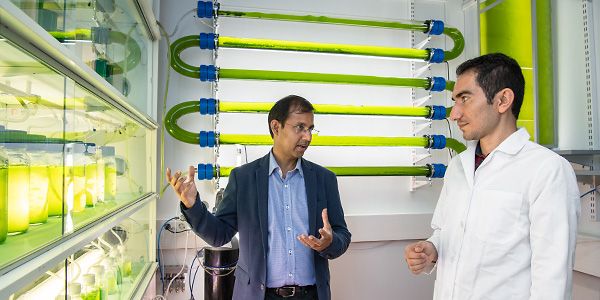Microalgae: Green Gold of the Future Able to Clean Wastewater and Produce Bioenergy
Published on by Water Network Research, Official research team of The Water Network in Case Studies
Wastewater purification is expensive, as it requires plenty of chemicals and energy. Thanks to microalgae – or phytoplankton – however, wastewater can now be efficiently treated in closed photobioreactors or open ponds, while also effectively recovering nutrients. Algae biomass can also be used for the production of bioenergy.

The University of Eastern Finland is currently conducting unique research into microalgae. Associate Professor Amit Bhatnagar, working at the Department of Environmental and Biological Sciences in Kuopio, investigates the potential applications of microalgae in different fields, including wastewater treatment and bioenergy production.
“Microalgae are green gold! We study different types of microalga that can typically be found in freshwaters as well as in saline waters,” Bhatnagar explains.
“Microalgae growth is dependent on the nutrients and other impurities found in wastewater. We are now studying different types of wastewater, such as wastewaters from the aquaculture, dairy and paper industries. Our objective is to screen optimal conditions for maximising microalgae growth.”
The paper and pulp industry is the third largest producer of wastewater in amount, and causes harmful effects on the environment and on human health. This wastewater is typically high in carbon but low in nitrate and phosphate (nutrients). However, these nutrients are essential for the growth of microalgae. To overcome this problem, one solution is the mixing of wastewaters with low concentrations of nutrients (e.g. pulp wastewater) and other wastewaters containing high concentrations of nutrients (e.g. aquaculture wastewater). This will allow the balancing of nutrients for the effective growth of microalgae and also efficient wastewater treatment.
“Microalgae grow best in optimised environments,” Bhatnagar says.
“We can increase the amount of algae biomass by adjusting the light, temperature and pH conditions. Different species of microalgae also have their individual characteristics. So far, we have grown microalgae in different types of photobioreactors.”
“It is possible to build a water purification system based on microalgae. This could even be a new opening for the new Finnpulp factory that is being planned in Kuopio,” Bhatnagar concludes.
“We still don’t have sustainable solutions for wastewater purification. At the moment, wastewater treatment requires lots of energy and use of toxic chemicals. We need to have sustainable solutions for wastewater treatment with the focus on resource recovery. Using microalgae is an easy and affordable way to treat wastewater, and no toxic chemicals are needed in the process.”

Amit Bhatnagar and Early Stage Researcher Ehsan Daneshvar
Microalgae have multiple uses today and in the future
“Microalgae are a rich source of valuable components such as lipids, carbohydrates, proteins, and pigments, which are used in food and feed production, bioactive pharmaceuticals, nutraceuticals, functional foods, and bioenergy (biodiesel, bioethanol or biogas)”, Bhatnagar says.
The amount of microalgae needed for the production of biodiesel depends on the composition of fatty acids in the biomass. In certain algae species, it is possible to increase their fatty acid content up to 50%.
Microalgae can also contribute to climate change mitigation, as microalgae have the capability to utilise CO2 as a carbon source, and biomass produced from microalgae can be used as a feedstock for other value-added products.
“Here in Finland, the lack of sunlight and cold temperatures are a problem for the practical application of microalgae during the winter. Nevertheless, we are trying to identify local species of microalgae, which can easily adapt to the harsh conditions,” Bhatnagar says.
“There are also new opportunities in the fields of bioplastics and biomedicine. We are now truly harnessing the green gold for the benefit of our future.”
References:
- Ehsan Daneshvar, Laura Antikainen, Eleni Koutra, Michael Kornaros, Amit Bhatnagara, "Investigation on the feasibility of Chlorella vulgaris cultivation in a mixture of pulp and aquaculture effluents: Treatment of wastewater and lipid extraction", Bioresource Technology, Vol 225, May 2018, DOI: 10.1016/j.biortech.2018.01.101
- Ehsan Daneshvar, Mohammad Javad Zarrinmehr, Atefeh Malekzadeh Hashtjin, Omidvar Farhadian, Amit Bhatnagar, "Versatile applications of freshwater and marine water microalgae in dairy wastewater treatment, lipid extraction and tetracycline biosorption", Bioresource Technology, Volume 268, November 2018, DOI: 10.1016/j.biortech.2018.08.032
- Ehsan Daneshvar, Mohammad Javad Zarrinmehr, Eleni Koutra, Michael Kornaros, Omidvar Farhadian, Amit Bhatnagar, "Sequential cultivation of microalgae in raw and recycled dairy wastewater: Microalgal growth, wastewater treatment and biochemical composition", Bioresource Technology, Volume 273, February 2019, DOI: 10.1016/j.biortech.2018.11.059
- Ehsan Daneshvar, Chella Santhosh, Eero Antikainen, Amit Bhatnagara, "Microalgal growth and nitrate removal efficiency in different cultivation conditions: Effect of macro and micronutrients and salinity", Journal of Environmental Chemical Engineering, Volume 6, Issue 2, April 2018, DOI: 10.1016/j.jece.2018.02.033
Media
Taxonomy
- Microorganism
- Treatment
- Wastewater Phycoremediation
- Industrial Wastewater Treatment
- Water Treatment & Control
- Waste Water Treatments
- Decontamination
- Bioaugmentation
- Biological & Chemical Quality
- Algaecides
- Wastewater Treatment
- Microbiology
- Biochemistry
- Biofuels
- Environment & Water
- Algae Treatment
- Water microbiology
- Biomass
- Bioenergy
- Bioenergy Technology
- Pulp & Paper